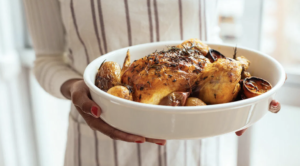
- Research shows the average person will gain 0.82 pounds during the Thanksgiving and Christmas holidays.
- Nutritionists say there’s much we can do to prevent overeating during this time of the year.
- Being aware of what a healthy portion size looks like can help. Changing your cooking methods and making healthier substitutions will go a long way as well.
Thanksgiving is notorious for being a holiday when many of us overindulge in our favorite fatty and sugary comfort foods.
“Which, if it’s just one day, isn’t all that bad,” noted Shereen Jegtvig, a nutritionist at the University of Bridgeport in Connecticut.
However, she points out that often, “the problem is that Thanksgiving is just the beginning of the holiday feeding frenzy.”
In fact, a 2016 study reported that the average American’s weight increases by 0.2 percent over Thanksgiving and 0.4 percent over Christmas. The study further noted that the average person gains about 1 pound each holiday season.
While this may not seem like much, researchers say we often don’t lose this gain after the holidays, leading to creeping weight gain.
It doesn’t have to be this way, though. By keeping an eye on portion sizes and choosing healthier options, we can enjoy our Thanksgiving meal without the worry of potential weight gain.
What is a healthy portion size for your favorite Thanksgiving foods?
Regarding portion sizes, Jegtvig points out that serving size and portion size aren’t necessarily the same thing.
The serving size is a fixed amount — for example, 1/2 cup — that’s used to calculate the number of calories in a particular item.
The portion size, however, is how much you choose to eat of that item.
So, the portion size might be equivalent to several servings, depending how much you choose to eat.
Eating healthier, then, is about making better choices in how we prepare foods as well as eating portion sizes that are appropriate for our personal nutritional needs.
Jegtvig suggests that the serving size is often a good starting point in judging what’s a healthy portion size.
The following information can be used as a guide to help you select healthy portion sizes for several popular Thanksgiving dishes, but your individual needs will vary.
Unless otherwise stated, calorie ranges are estimated based upon data from the Department of AgricultureTrusted Source.
-
Roasted turkey
A healthy serving size of roasted turkey usually contains between 120 and 165 calories. Getty Images Serving size: 3 ounces
Calories: 120 to 165
Healthier options: “Turkey is good. It’s a great source of protein without being high in saturated fats,” Jegtvig said.
Preparation method does matter, however.
Deep-frying turkey will add more fat and calories. Leaving the skin on will also add to the count. The cut selected matters too.
Your best choice? Roasted breast meat with the skin removed.
-
Stuffing
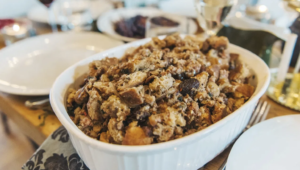
One serving of stuffing is 1/2 cup and usually contains between 110 and 200 calories. Getty Images Serving size: 1/2 cup
Calories: 110 to 200
Healthier options: Jegtvig advises that adding more vegetables to your stuffing is a good way to make your meal more healthy.
So, with a dish like stuffing, you could add more vegetables to your recipe while going lighter on bread, meat, and added fat.
-
Mashed potatoes
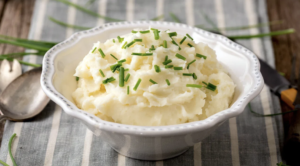
A 1/2 cup of mashed potatoes (a single serving) typically contains 210 to 240 calories. Getty Images Serving size: 1/2 cup
Calories: 210 to 240
Healthier options: Use fat-free milk and low-sodium chicken broth instead of whole milk and butter.
Sharon Palmer, a registered dietitian and nutritionist, suggests you could also try adding carrots or celery to the mashed potatoes to lighten them.
Olive oil is also a healthier alternative to butter.
-
Gravy
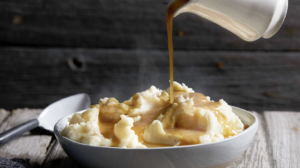
A serving of gravy (1/4 cup) is typically high in fat and contains around 15 to 35 calories. Getty Images Serving size: 1/4 cup
Calories: 15 to 35
Healthier options: When preparing your gravy, keep in mind that the pan drippings are full of fat (56 grams per cup of gravy). Refrigerate first, and remove the solidified drippings before preparing your gravy.
Jegtvig suggests that you should watch your intake of gravy since it’s so fatty. Keep your portion small.
-
Green bean casserole
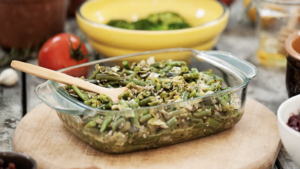
A serving of green bean casserole contains anywhere from 89 to 240 calories depending on its ingredients. Getty Images Serving size: 1/2 cup
Calories: 89 to 240
Healthier options: According to Campbell’s, you can substitute Campbell’s Healthy Request Condensed Cream of Mushroom Soup for their regular soup. Use 1 percent milk instead of whole. Substitute 2 tablespoons and 1 cup french fried onions for 1 can of french fried onions.
These changes will greatly reduce the fat and calories compared with the original recipe. You may also use reduced-sodium soy sauce if you’re concerned about your sodium intake.
Jegtvig recommends that you “could go with something like green beans with almonds and lemon juice instead of a high calorie casserole” for an even healthier option.
-
Macaroni and cheese
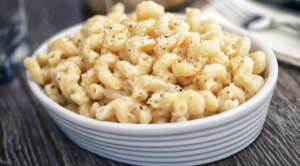
A 1/2 cup is the serving size for mac and cheese, which usually contains between 225 and 290 calories. Getty Images Serving size: 1/2 cup
Calories: 225 to 290
Healthier options: Substitute low fat milk and cheese in your recipe. Use whole wheat pasta to boost fiber.
Palmer suggests using “butternut squash, carrots, or peas to mix in more veggies and lighten up the recipe.”
-
Sweet potato casserole
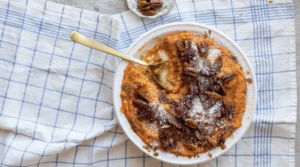
A single serving of sweet potato casserole has 105 to 225 calories. Getty Images Serving size: 1/2 cup
Calories: 105 to 225
Healthier options: On their own, sweet potatoes are actually a very healthy option.
The key is to go easy on what you add to them. When you add in marshmallow, brown sugar, and butter, this adds significantly to your intake of calories, fat, and sugar.
“Cut down on the sweeteners and marshmallows and add fruit, such as dried apricots or peaches, to offer natural sweetness. Also, cut down on the margarine or butter,” Palmer said.
-
Cranberry sauce
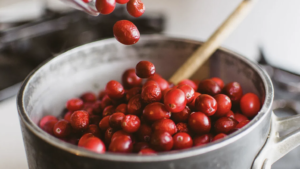
One serving of cranberry sauce contains roughly 110 to 160 calories. Getty Images Serving size: 1/4 cup
Calories: 110 to 160
Healthier options: Cranberries themselves are very healthy. They’re low in sugar and carbohydrates while also being high in nutrients and fiber.
When prepared as cranberry sauce, however, they become very high in added sugar. The key to a healthier preparation is to add sweetness by using fruit or a non-sugar sweetener, such as stevia.
Palmer suggests you could also make a fresh cranberry relish, which is very flavorful but with less sugar.
-
Rolls
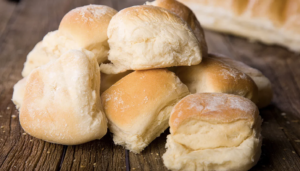
The average serving size of a bread roll contains 210 to 270 calories. Getty Images Serving size: 1 roll
Calories: 210 to 270
Healthier options: When it comes to bread, your best option is whole grain breads. Whole grain contains vital nutrients that get stripped out of processed grains. They’re also higher in fiber.
Palmer suggests keeping the size of rolls small.
-
Pumpkin pie
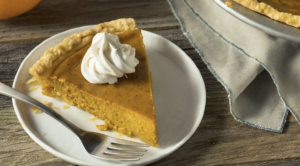
A serving size of pumpkin pie contains 290 to 375 calories. Getty Images Serving size: 1 slice
Calories: 290 to 375
Healthier options: Dr. Michael Greger suggests making such substitutions as pitted dates to eliminate added sugar and whole wheat pie crust for its added nutrition and fiber.
Tofu can substitute eggs and milk to reduce saturated fat and cholesterol, too.
Original source: https://www.healthline.com/health-news/healthy-portion-sizes-for-10-thanksgiving-favorites#What-is-a-healthy-portion-size-for-your-favorite-Thanksgiving-foods?
